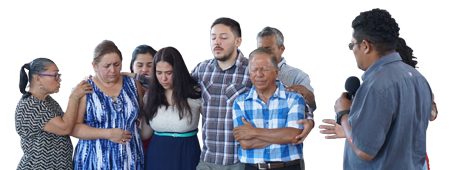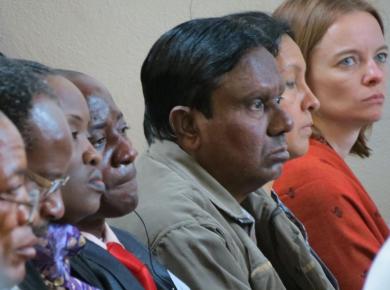Posted: May 19, 2016
In 2012, MWC partnered with the Institute for the Study of Global Anabaptism (ISGA) at Goshen College (Goshen, Indiana, USA) to launch a multi-year, multi-part research initiative. The goal? To develop a more nuanced picture of the MWC constituency specifically, and the global Anabaptist church generally.
The project has two components. The first, the Global Anabaptist Profile (GAP), is a survey structured around MWC’s “Shared Convictions” that aims to collect demographic data as well as information on beliefs and practices. The second component, the Bearing Witness Stories (BWS) Project, will seek to gather personal stories of discipleship and suffering, in the spirit of the Martyrs Mirror.
Recently, Courier/Correo/Courrier connected with project personnel to discuss the initiative, its impetus and its progress thus far.
What was the impetus for this research initiative on global Anabaptism?
John D. Roth (JR): The global Anabaptist church has been undergoing a dramatic transformation in the past 30 years or so, growing from approximately 600,000 members in 1980 to nearly 1.7 million today. Although MWC has worked hard to facilitate exchanges among its member groups, we are still very much in a process of learning to know each other better. The project is one step in helping to clarify a better sense of the basic demographical information, while also gathering much more detailed information about the beliefs and practices, hopes and dreams of MWC member churches.
Have there been other such efforts to study the beliefs and practices of the international Anabaptist-Mennonite community?
Conrad Kanagy (CK): Not many. Several years ago, Richard Showalter – then-president of Eastern Mennonite Missions and chair of the MWC Missions Commission – and I inaugurated the Multi- Nation Anabaptist (MNA) Profile. Ours was an effort to learn more about the beliefs and practices of the international Anabaptist community, and specifically those national churches connected to EMM. The results of that study were recently published in the book Winds of the Spirit (Herald Press, 2012).
Alfred Neufeld (AN): Winds of the Spirit is excellent proof of how a profile study can stimulate theological work and contribute to renewal of identity. We expect that the GAP will similarly help our Commission in its efforts.
CK: The GAP will be broader in scope than the MNA, and we hope it will yield even greater insights.
How do you plan to gather stories for the “Bearing Witness” project?
JR: One aspect of the project will focus on pulling together stories in a more intentional fashion from the 18th, 19th and 20th centuries (i.e., from the completion of the Martyrs Mirror in 1685 to the present). But we also want to gather stories from the contemporary church, and especially from Anabaptist-Mennonite churches in the Global South.
In August 2012, some 40 people from nine countries (and representing at least six different Anabaptist groups) met at Goshen College to develop a framework for the BWS. The consultation made it clear that gathering stories is never a simple process. We hope that a combination of active personal solicitation, the Internet, public appeals and the use of existing networks (like MWC) will slowly generate interest.
What progress has been made thus far on the project?
JR: Following nearly a year of conversations with MWC leadership, mission agency executives, representatives from Mennonite Central Committee and a host of interested individuals, the ISGA received preliminary approval for the project by the MWC Executive Committee at its May 2011 meeting, with final approval confirmed at the meeting of the General Council in May 2012.
In August 2012, a sub-group of the MWC Faith and Life Commission met to review the logistics of the GAP. Also in August, Conrad organized a consultation with several other Mennonite sociologists, each with extensive experience in crosscultural surveys, for counsel regarding methodological questions. In late October we finalized our sample, and in November the MWC office in Bogotá sent out official letters to a representative sample of 25 member-churches, inviting them to participate. Right now we are responding to questions and confirming which groups wish to take part in the project. We hope to complete the survey in 2013-2014.
It’s common these days to find North American researchers going to the Global South to conduct these kinds of studies. I’m sure that you’re sensitive to this perception with the current project. What steps have you taken to address this perception?
JR: Yes, some might have the perception that this is a purely North American academic project that is “extracting” information from the global church. That is a false impression, though I do understand the concern. Clearly, the ISGA – which is located in the USA – is a catalyst for the project, and all of the funding comes from North America. But we see this as a project owned jointly by all the member-churches in the MWC family. The survey itself is based on the MWC Shared Convictions that resulted from a long process of discernment that included input from groups around the world. Each participating group will have a chance to add to the GAP questions that are specific to its setting. And the results of each participating group’s survey will be made available in an accessible form to the leadership of each church.
Gathering information is not an end in itself; the information is clearly intended to help the church – both locally and in its global/MWC expression – to be more faithful followers of Jesus.
How do you think the data gathered in this project will help MWC in its work of linking the global Anabaptist community?
AN: In the 16th century there was a “multigenesis” of Anabaptist beginnings: the Dutch-North German group, led by Menno Simons, was quite different in culture, history, spirituality and political setting to the Swiss-South German group that began 1525 in Zurich. And both groups had considerable differences from the movement led by Hans Hut and Thomas Müntzer, and from the later “Heavenly Kingdom” at the city of Münster.
Today, young Anabaptist churches – those within an Islamic context in Indonesia or Nigeria, within a Spanish Conquistarooted Catholic context in Latin America, or within the “underground church” movement in China – have quite different spiritual lives and day-to-day struggles than our Mennonite church members in Holland or Switzerland, in the USA or Canada. But we need each other and we need to understand each other.
CK: In the Book of Revelation, Jesus Christ has a message or word for the seven churches of Asia. I like to imagine that the work of MWC in this project will be one more way of hearing – partially, of course – Christ’s word to us in these early years of the 21st century.


Join the Conversation on Social Media
FacebookTwitterInstagramFlickrYouTube